Click on images to enlarge
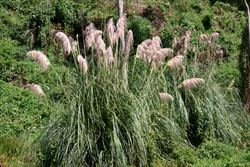
infestation (Photo: Trevor James)
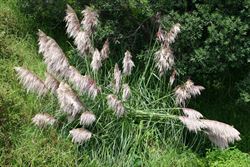
habit in flower (Photo: Trevor James)
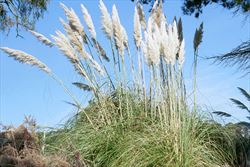
habit with mature seed-heads (Photo: Rob and Fiona Richardson)
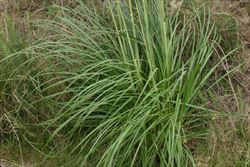
leaves (Photo: Trevor James)
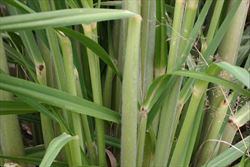
stems, hairy leaf sheaths and leaf blades (Photo: Trevor James)
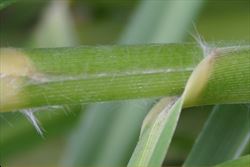
close-up of stem and base of leaf blade (Photo: Trevor James)
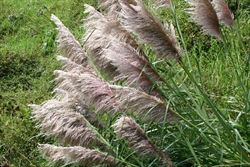
seed-heads (Photo: Trevor James)
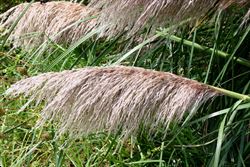
seed-head (Photo: Trevor James)
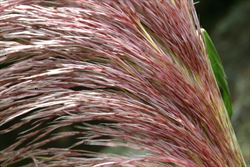
close-up of flower spikelets (Photo: Trevor James)
Scientific Name
Cortaderia jubata (Lem.) Stapf
Synonyms
Gynerium jubatum Lem.
Family
Gramineae (South Australia)Poaceae (Queensland, New South Wales, the ACT, Victoria, Tasmania, Western Australia and the Northern Territory)
Common Names
Andean pampas grass, Andes grass, Andes pampas grass, cortaderia, jubata grass, jubatagrass, pampas grass, pampasgrass, pink pampas, pink pampas grass, purple pampas, purple pampas grass
Origin
This species is native to South America (i.e. Argentina, Bolivia, Ecuador and Peru).
Cultivation
Though not as common in cultivation as pampas grass (Cortaderia selloana), this species has been widely grown as a garden ornamental in southern Australia.
Naturalised Distribution
This species is becoming widely naturalised in the south-eastern parts of the country (i.e. it is relatively common in Tasmania and southern Victoria and present in the coastal districts of central New South Wales). Also occasionally naturalised in south-western Western Australia and south-eastern Queensland, and sparingly naturalised in south-eastern South Australia.
Naturalised overseas in southern Africa, New Zealand, western USA (i.e. California and Oregon) and Hawaii.
Habitat
A weed of temperate regions that colonises roadsides, waste areas, disturbed sites, waterways, coastal environs, grasslands, pastures and disturbed forests. It is also found in and near parks and gardens.
Habit
A large and long-lived (i.e. perennial) tussock-forming grass with upright (i.e. erect) flowering stems usually growing 2-3 m tall, but sometimes reaching up to 4.5 m in height.
Distinguishing Features
- a large and long-lived grass forming a large tussock and producing thick flowering stems up to 4.5 m tall.
- its long and narrow leaves (up to 2 m long and 4-30 mm wide) have margins that are finely and sharply toothed.
- its pink or purplish seed-heads are very large (30-90 cm long), plume-like, and borne at the top of the flowering stems.
- these seed-heads usually fade to a yellowish, whitish or dull brown colour as they mature.
- they are made up of numerous small flower spikelets that each contain three to five tiny florets.
- the florets have long silky hairs (7-8 mm long) which give the seed-head its feathery appearance.
Stems and Leaves
The bright green or dark green leaves of this species are mostly produced from the base of the plant and form a large tussock. These leaves are followed by upright (i.e. erect) flowering stems that are relatively thick (up to 3 cm across) and hollow.
The large leaves consist of a short whitish-coloured sheath, that clasps the stem at the base, and a spreading leaf blade. The leaf sheaths are hairless (i.e. glabrous) or variously hairy (i.e. pubescent to puberulent) and the long and narrow (i.e. linear) leaf blades (up to 2 m long and 4-30 mm wide) taper to a fine tip (i.e. they have acuminate apices). Their margins are finely and sharply toothed (i.e. serrate) and they often droop somewhat, with many of the older leaves touching the ground. There is a line of hairs (i.e. a ciliate ligule), about 1-3 mm long, where the leaf sheath meets the leaf blade.
Flowers and Fruit
The plume-like seed-heads (i.e. open panicles) are very large (30-90 cm long), feathery, and are initially somewhat pinkish or purplish in colour. They are borne at the tops of the thick flowering stems and fade to a yellowish, whitish or dull brown (i.e. biege) colour as they mature. The many narrow (i.e. lanceolate) flower spikelets (12-16 mm long) each contain several (3-5) small florets that are contained within two purplish-coloured bracts (i.e. glumes). These florets have long silky hairs (7-8 mm long), which give the seed-head its feathery appearance. Male and female (i.e. unisexual) florets are usually produced on separate plants (i.e. this species is dioecious), and female-flowered plants are normally only present in wild populations in Australia. Flowering occurs mostly during summer, but also in late spring and early autumn.
The oval (i.e. ellipsoid) seeds (i.e. grains or caryopses) are straw-coloured or dark brown. These seeds (2-2.5 mm long and about 0.5 mm wide) are enclosed within two bracts (i.e. a palea and lemma).
Reproduction and Dispersal
Female-flowered (i.e. pistillate) plants are normally only present in Australia and, because there are usually no male flowers, seeds are produced vegetatively (i.e. by apomixis). However, bisexual plants have recently been found to be widely spread throughout the south-western parts of Western Australia.
Seeds are dispersed mostly by wind, but sometimes also by animals and machinery. The tussocks and creeping underground stems (i.e. rhizomes) of this species may also be spread in dumped garden waste.
Environmental Impact
This species is regarded as an environmental weed in Victoria, New South Wales, Tasmania and Western Australia. It is the most aggressive of the three pampas grass (Cortaderia spp.) species that are naturalised in Australia, and is now the most common pampas grass (Cortaderia spp.) in New South Wales and Victoria. It is also replacing common pampas grass (Cortaderia selloana) as the major weedy pampas grass species in Tasmania.
Pink pampas grass (Cortaderia jubata) has the potential to become a serious weed in wetlands and disturbed areas in southern Australia. Once established, it forms dense stands and competes with or replaces native species. It rapidly colonises areas such as drains, firebreaks, road edges, logged or burnt sites and quarries and has also established itself in pine forests plantations and national parks in Tasmania. It has also become a major threat to national parks and conservation in and around Sydney and along the New South Wales central coast. This species is also an important environmental weed in other parts of the world, and is listed in the Global Invasive Species Database.
Other Impacts
In summer, the dense tufts of dead leaves can become a fire hazard. It also reduces the aesthetic values of conservation areas and limits recreational access along tracks. This species is also a potentially serious weed of forestry plantations.
As pink pampas grass (Cortaderia jubata) produces huge volumes of pollen, there is also the possibility that it could exacerbate asthma and hay fever conditions. The leaf edges are sharply serrated and they can easily cut the skin leaving irritating welts.
Legislation
This species is declared under legislation in the following states and territories:
- ACT: C4 - prohibited pest plant (a pest plant whose propagation and supply is prohibited).
- New South Wales: Class 4 - a locally controlled weed. The growth and spread of this species must be controlled according to the measures specified in a management plan published by the local control authority and the plant may not be sold, propagated or knowingly distributed (in a large number of local authority areas). See the New South Wales Department of Primary Industries Noxious Weeds List at http://www.dpi.nsw.gov.au for more detailed information on which local areas are covered in these declarations. This declaration also applies to all pampas grasses (i.e. Cortaderia spp.).
- South Australia: Class 1N - this species is a prohibited terrestrial plant which must be destroyed wherever it is found (throughout the entire state).
- Tasmania: D - the importation or sale of this species is prohibited and measures to reduce its population in an area, eradicate it from an area, or restrict it to a particular area may be required. This declaration also applies to all pampas grasses (i.e. Cortaderia spp.).
- Western Australia: Prohibited - on the prohibited species list and not permitted entry into the state.
Management
For information on the management of this species see the following resources:
- the New South Wales Department of Primary Industries Agfact on pampas grasses, which is available online at http://www.dpi.nsw.gov.au.
- the Tamar Valley Weed Strategy information page on pampas grasses, which is available online at http://www.weeds.asn.au.
- the Environmental Weeds Action Network information page on pampas grasses, which is available online at http://members.iinet.net.au/~ewan/index.html.
Similar Species
Pink pampas grass (Cortaderia jubata) is very similar to pampas grass (Cortaderia selloana) and New Zealand pampas grass (Cortaderia richardii). These species can be distinguished by the following differences:
- pink pampas grass (Cortaderia jubata ) has relatively dense and very large seed-heads (30-90 cm long) that are usually pinkish or purplish when young. Its leaves are usually bright green or dark green in colour and have a very prominent midvein.
- pampas grass (Cortaderia selloana ) has relatively dense and very large seed-heads (25-100 cm long) that are usually whitish or silvery when young. Its leaves are usually somewhat bluish-green or greyish-green (i.e. glaucous) in colour and have a very prominent midvein.
- New Zealand pampas grass (Cortaderia richardii ) has relatively sparse seed-heads (30-60 cm long) that are usually whitish or pale brown when young. Its leaves are usually somewhat bluish-green or greyish-green (i.e. glaucous) in colour, have a prominent midvein, and also have distinct secondary veins.
Pink pampas grass (Cortaderia jubata) is also relatively similar to giant reed (Arundo donax) and common reed (Phragmites australis). However, both of these species produce seed-heads at the top of stems that have numerous joints (i.e nodes) with alternately arranged leaves.

